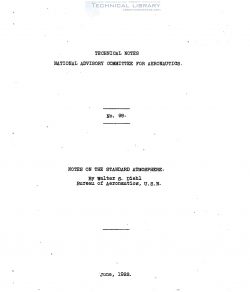naca-tn-99
- Version
- 125 Downloads
- 361.65 KB File Size
- 1 File Count
- November 3, 2016 Create Date
- November 3, 2016 Last Updated
National Advisory Committee for Aeronautics, Technical Notes - Notes on the Standard Atmosphere

This report contains the derivation of a series of relations
between temperature, pressure, density and altitude in a "stand—
ard atmosphere" which assumes a uniform decrease of temperature
with altitude; The equations are collected and given with proper
constants in both metric and English units for the temperature
gradient adopted.by the National Advisory Committee for Aeronau-
tics. A table of values of temperature pressure and density at
various altitudes in this standard atmosphere is included in the
report.
Certain interesting and significant relations exist between
pressure, density, temperature, and altitude in a "standard at—
mospheren which assumes a linear decrease of temperature with al-
titude. such an atmosphere is in extensive use in EurOpe and ha'
recently been adqpted by the National Advisory committee for aero
nautics for official use in the United states. The derivation of
the more important of the standard atmosphere relations and their
tabulation in form for ready reference seems to be a practical
method of indicating the way towards a utilization of the many
advantages of a standard atmosphere.
A discussion of standard Atmosphere may be found in National
Advisory Committee for Aeronautics Report NO. 147, by W} R. Gregg-
A few brief remarks will be made for the benefit of those who do
'do not have a copy of that report available for reference.
"standard Atmosphere," as the name implies, is an atmosphere
in which fixed values of pressure, temperature and density are
adopted, more or less arbitrarily, for each altitude; such an at~
mosphere is required in comparing the performance of aircraft and
aircraft power plants. The most satisfactory of all proposed.
while it is desirable that a standard atmosphere be a close
approximation to actual conditions, this requirement should not be
.stressed. The chief purpose of a standard atmosphere is to supply
a basis for comparison of performance and not to specify the tem-
perature and pressure obtaining at a given absolute altitude at
all times. It so happens that "Toussaint's Rule" expresses with
. considerable accuracy the average annual conditions for latitude
40° in the United states. This is not altogether accidental since
the temperature gradient is based on averages, but it is very
doubtful if the standard atmosphere ever expresses the true condi—
tions at a given instant. nevertheless, the "standard atmosphe::“
when properly understood and used is of great value in aeronautics.
| File | Action |
|---|---|
| naca-tn-99 Notes on the Standard Atmosphere.pdf | Download |

Comment On This Post